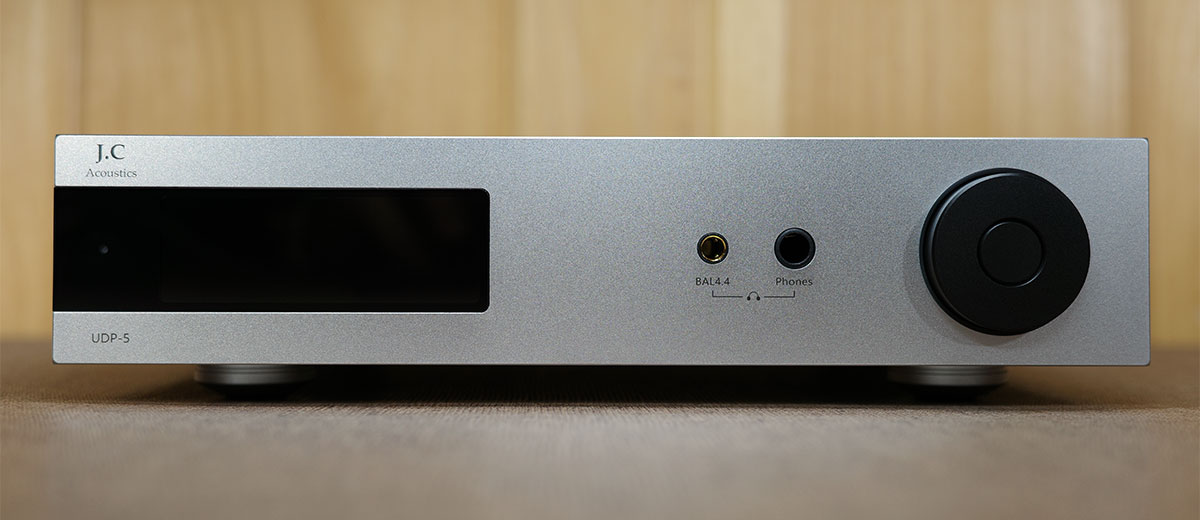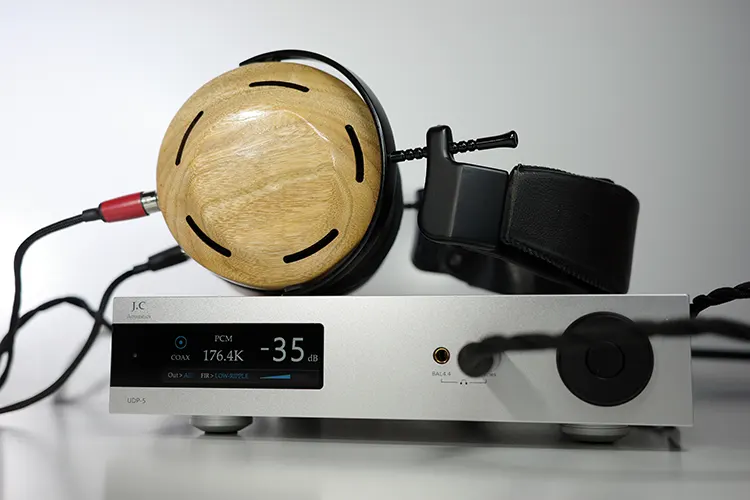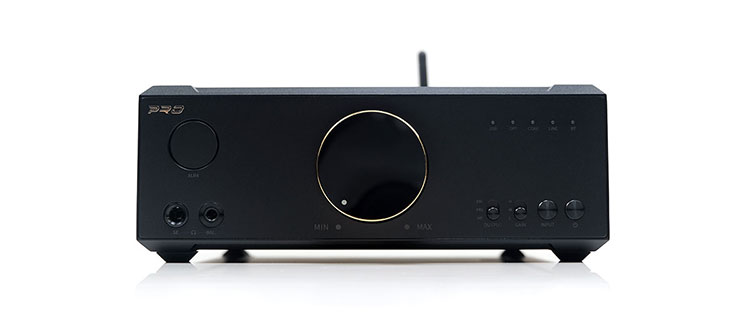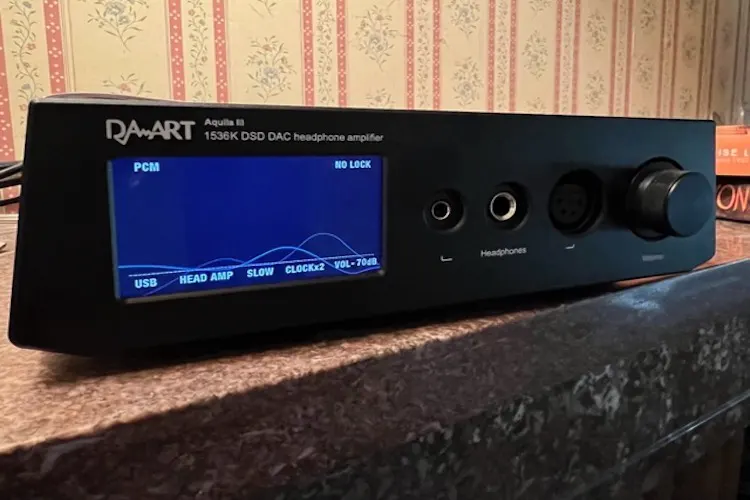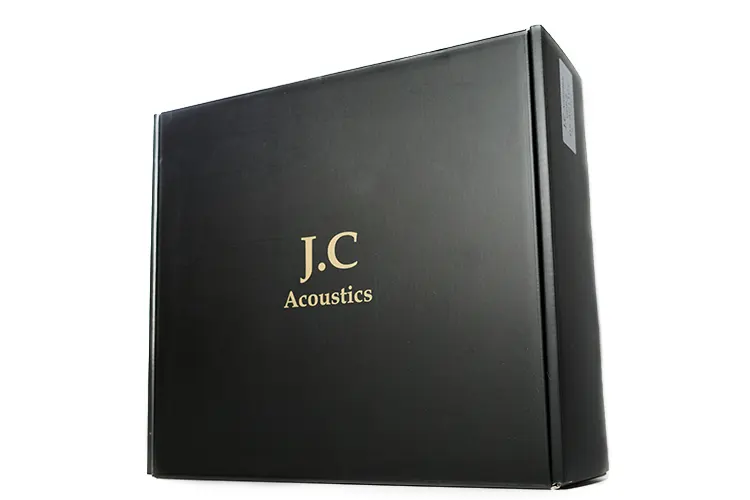Synergy
Efficiency
With an SN ratio of 118 dB and 6800mW max in the 4.4mm balanced jack, the background was dead silent. Even on higher volumes with the accurate AKG240DF, there was no background noise.
This added to the overall smooth character, without encumbering the sound, no matter the listening source. Hard-to-drive headphones presented the same quality character as efficient IEMs.
Using the Oppo BDP-83 going from SPDIF to SPDIF, then RCA-out to the Klipsch The Sixes showed you needed plenty of power to properly drive them, and this almost became my favorite pairing.
I could easily see this being a viable setup when not using it for headphone listening.
Power
With a maximum of 6800mW at 32Ω on the 4.4mm balanced jack, there is plenty of power to drive your listening to damaging levels. I rarely had to go beyond -40 dB when using headphones such as the Crosszone CZ-8A Enhanced or -45 dB with the Empire Ears Legend X.
This power carried well across many listening sources but did not come about as instantly shouty as the insanely powerful xDuoo TA-30 does when raising the volume. I again appreciated the linearity with which that power was delivered.
Pairings
Having purchased the AKG240DFs for an earlier review of the Drop x XDuoo TA-84 I decided to use them here as well. At 600Ω, this is the hardest-to-drive headphone I own along with the Drop x Sennheiser HD 6xx.
While I did have to run the volume up to -13dBs sometimes, I never felt like the UDP-5 was shorting the AKG on voltage. Even with the minimal 90mW, the sound came across as smooth and naturally musical.
The ZMF Headphones Eikon sounded just as good but was easier to drive at 300Ω. Keeping the volume at about -31dBs afforded excellent bass response, and an accurate tonality to the music, which was expected.
I never felt like the UDP-5 was shorting the Eikon in providing enough voltage to fulfill the sound signature, either. Known as one of the bassier ZMF units, the UDP-5 presented an accurate representation of the Eikon’s signature through the music played.
The Crosszone CZ-8A Enhanced is in for an independent review, but I felt was a valid comparison here since it fits well with the AKG240DF and Eikon. Capitalizing fully on the 4.4 balanced power, I was able to keep the volume lower by about -10 dBs at between -40 dBs to -50 dBs providing a full, rich signature.
I was able to keep the volume within 5-10 dB of the Eikon. The bass was taut and controlled, with the mids pushed upward more than the others.
This was the one IEM/headphone test where I had to sort through the filter choices to give me what I considered the best choice. In other words, less peakiness up top. I settled on a Linear Phase slow-roll-off filter for the best listening.
Select Comparisons
FiiO K9 Pro ESS
Technical
The K9 Pro ESS shares the same ES9038Pro x2 DAC chips (one per channel) as the UDP-5 but uses THX AAA788+ amplifier technology alongside its dual femtosecond clock system.
It also carries the QCC5124 BT5.2 capable chip while supporting up to LDAC decoding. It also has a dual voltage linear transformer to keep the whole system isolated just like the UDP-5.
The in-house power supply does a nice job of keeping all functions isolated to prevent potential interference from ruining the experience. Separate power supplies for analog & digital further keep potential audio interference away from the sound listening experience.
Design
A larger, chunkier rectangular box fits on a smaller scale, width-wise while still being able to fit into a user’s desktop situation.
Also included is a U-shaped canted bracket, which allows the user to run the FiiO vertically, taking up less space. When not using the FiiO for comparative purposes, I keep it running in the vertical sphere to save space.
One large gold-ring lined knob dominates the front middle, with push buttons to the right, which control output, input, gain, and power.
The gain and output “buttons” actually toggle between the choices. They are 4.4mm balanced, 3.5mm SE, and XLR 4-pin headphone jacks. Efficient in design, the FiiO lights up around the ring for the sampling rate in wired tech or BT codecs of each song since there isn’t a screen for help.
The two share input and outputs, except the K9 Pro ESS, which gains a 4.4mm balanced input and RCA-in whereas the UDP-5 has neither.
Performance
Where the UDP-5 mimics an AKM chip, the K9 Pro ESS sounds distinctly like an ESS-tuned machine. Vibrant tonality rules here, with a succinct note treatment, without being thin sounding.
If you desire clarity with detail retrieval typical of an ESS; then the FiiO is an easy choice. However, the ESS adds good note weight to help balance the sound from becoming too analytical or dry.
There is also some good texture to the notes and instruments; lending a natural extension that keeps the songs engaging but not too slow.
The UDP-5 provides more power than the FiiO, even with the three gain settings, and I found I had to raise the volume markedly to accommodate a seat-of-the-pants equality to the level I heard.
I found myself appreciating the smooth laidback texture of the UDP-5 while appreciating the added detail retrieval of the K9 Pro ESS, without losing good depth to the notes on the low end.
I appreciate each other’s strengths while also understanding each other’s limitations. If a smoother signature with good bass, which lacks the overall clarity is your cup of tea, then the UDP-5 might suit you better.
However, if you prefer a natural accuracy to the sound, which also carries good depth and a bit too much energy up top on some songs; then the FiiO will be appreciated.
YULONG DA-ART Aquila III
Technical
The Aquila III comes packaged with YULONG’s new 5th-generation Jitter and Interface Control system (JIC).
It also has a proprietary USB interface based on their ARM+FPGA architectures with AK4191+AK4499EX chipset, which enables decoding up to class-leading levels, including PCM1536Khz and DSD 1024 files.
Dual clock modes (similar to the ASRC and SYNC modes on the Aquila II, labeled Clock-1 and Clock-2) allow for two signatures along with three different filter options (short, sharp, slow).
The Aquila III also carries a DC-coupled Class A design that can operate as a preamp or a dedicated headphone amplifier.
It has a single-ended dual RCA and a 3-pin XLR (analog) output to the rear along with balanced 4.4mm, 4-pin XLR, and a 6.35mm single-ended output on the front. Built-in gain control is again left out, leaving you with the détente of a 99-step volume control knob for adjustment.
Power provides up to 4W (32Ω, balanced) and 1w (32Ω, single-ended) is less than the UDP-5, but it does not play that way. An output impedance of less than 1Ω makes for a black background. The Aquila III had no issues driving any of the headphones or IEMs I used when testing it in September 2023.
Design
Similar to the Aquila II, the combination of isosceles trapezoidal angles gives the listener a fresh approach. I have grown to appreciate its different style from the normal black or silver box.
With more heft to it than the UDP-5, (4 kg vs 3kg), the Aquila III can hold a place on your desk without embarrassment. The vast majority of the display on the front left side features a spectral analyzer.
Four menu options (input, output, filter in use, and clock in use) lie below, which can be easily accessed by pushing the volume knob, highlighting the chosen menu. You also get a 4-pin XLR headphone jack, which the UDP-5 does not carry.
Performance
Two distinct sound signatures emanate from the Aquila III matching the literature-cited Clock-1 (YULONG JIC, lower oversampling rate with a punchy, more analog sound) and Clock-2 (AK4499, with default sampling mode promoting “outstanding resolution and details”).
Clock preference changed with headphones/IEMs used in my tests. I prefer the Clock-2 setting and used it throughout the comparison.
I mentioned earlier that the Aquila III would be a scalpel to the UDP-5’s quality bread knife. While each serves its purpose well, there is no hiding that the UDP-5 cannot match the level of detail retrieval coming from the Aquila III.
However, with the proper filter choice, the Aquila III can get a vibrant signature that also carries a rich tonality with it. For critical listening, the Aquila III is an easy choice at this level, without giving up the textural details, that make a signature musical as well.
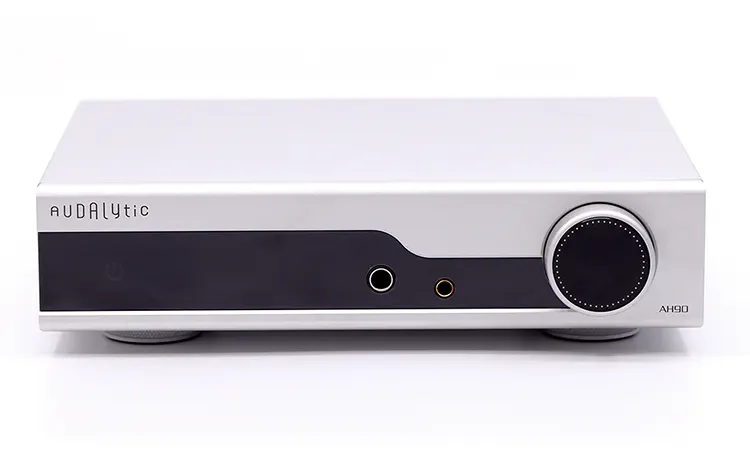
Audalytic AH90
Technical
The Audalytic AH90 is another standalone midrange desktop DAC. It uses the latest AKM AK4499EX DAC and AK4191EQ modulator chipset, separating the digital and analog circuitry as well as isolating the signal from external interferences.
With a third-generation 16-core XMOS XU316 (as opposed to the XU216 in the UDP-5) USB interface, (similar to the FiiO R9 we recently reviewed, and the UDP-6), the AH90’s USB-C decoding supports high-resolution audio streams of up to PCM 32BIT/768 kHz, native DSD512, and MQA 8x.
The combination allows for better control using the CK01 clock module and FS jitter oscillators. The FPGA architecture provides precise signal routing phase loop locking, DOP decoding, and a PCM-DSD silent switch, concerning stability in the signal flow, digitally speaking. All items are similar to the UDP-5’s setup.
The AH90 is also a network streamer, supporting Roon Bridge (based around the Gustarender), UPnP, HQ Player, Spotify, Tidal, and Airplay streaming functions through either the LAN connection or directly from the source connected. Something the UDP-5 lacks.
There is no BT or WiFi, but the lack of that makes it on par with the UDP-5 interfaces.
Amplification
Supporting both single-ended and balanced headphones, using the 6.35mm single-ended and 4.4mm balanced headphone ports, this provides a leg up on the UDP-5.
The output provides a 1W maximum at 32Ω (from 64Ω down) through the balanced connection and 200mW at 300Ω, which falls well short of the UDP-5 and it shows when playing.
Power is provided through 2 OPA1612 bipolar-input Op-Amps, using Burr Brown Texas Instrument technology. With rail-to-rail output swings to within 600 mV on a 2-kΩ load, this increases headroom, while maximizing dynamic range.
The typical Burr Brown sound signature of smoothness pervades the AH90 as a result. The small size helps to keep the circuitry diminutive within the AH90.
Design
The AH90 comes in either silver or black, with a curved glass insert. The silver highlights the curved glass better to me, with an easier-to-read LCD.
It has a design similar to the Gustard A26 and R26 (curved glass effect) and comes across with a diminutive footprint. The unit measures 220mm x 170mm x 50mm with a minimal 2kg weight. This is much lighter than the UDP-5, which I attribute to the toroidal transformer.
A large knob dominates the right side of the front, but other than the touch-sensitive on/off “button” that knob controls all features. The use of the knob was direct and without any faults or construction snafus.
The black plastic knob (and its surrounding silver ring) controls which source you are using by a single push. A short press changes sources while a longer press affords access to the sub menus including gain, filter choice, phase changing, and assorted other features.
The design is elegant and functional yet carries a modern look to it as well. The AH90 can easily slip under your desktop monitor, or next to your system, minimizing its presence while doing so; much like the UDP-5
Performance
Burr Brown DACs are known for a smooth relaxing signature, and the AH90 is no different. While the sound emanating from within is indeed smooth, there is still plenty of detail wrought from the sound signal. This signature is indeed smoother and richer than the UDP-5 but lacks the detail of the latter.
Where the UDP-5 presents a smooth-sounding ESS chipped set, the AH-90 is all Burr Brown. If you prefer a laidback signature, that comes across as completely unoffending but lacks the micro details of some then the AH-90 will appeal to you.
However, if you prefer a slightly tighter signature, that carries a bit of engagement to the sound too, then the UDP-5 might suit your need better.
While I like the functionality of the AH-90, the UDP-5 comes across as slightly more refined, with a smooth texture to the instruments, without becoming slow or sloppy.
The AH-90 does have streaming capabilities to it, but when you essentially hook your unit up to a streaming source, that becomes superfluous to me.
My Verdict
Having never heard anything from the new company, I was not sure what to expect from the UDP-5. Carrying many of the same components of the competitors, I could assume some things. I was wrong.
I have to admit that this may be the most “un-ESS-like” sounding DAC I have heard. While almost mimicking an AKM model, it does not lose the heritage of an ESS unit.
Levels of detail are good, without becoming sterile. Add in the smooth, natural-like signature and you have a DAC/headphone amplifier that seemingly runs the edge. And does so well.
The J.C. Acoustics UDP-5 entered a crowded sector and has to make enough of a splash to be different. It does things differently enough to make itself a consideration when looking for a quality desktop DAC/headphone amplifier, that can also slip into your two-channel system.
J.C. Acoustics UDP-5 Technical Specifications
- USB Input: DOP & Native DSD64-DSD512; PCM: 16-32bit, 32K-768KHz
- Coaxial/optical Input: PCM: 16-24bit, 32K-192KHz
- IIS-LVDS Input: DOP & Native DSD64-DSD512; PCM: 16-32bit, 32K-768KHz
- DAC parameters: XLR Output
- Frequency response: 20-40KHz, +/-0.2dB
- THD+N: 0.00021%, -6dB@1KHz/A-weight
- SNR: 118dB
- Channel separation: -131dB@1KHz
- Line-Out power: 2.3Vrms/RCA, 4.6Vrms/XLR
- Headphone amplifier parameters: 4.4mm balanced output
- Headphone port: 4.4mm balanced output, 6.35mm single-ended output
- THD+N: 0.00030%, 7Vrms@1KHz/A-weight/4.4mm balanced
- Frequency response: 124dB
- Channel separation: -129dB@1KHz
- 4mm balanced output: 6800mW@32 ohm, 720mW@300 ohm, 360mW@600 ohm
- 35mm single-ended output: 1680mW@32 ohm, 180mW@300 ohm, 90mW@600 ohm
- Standby power consumption: 3W, Working power consumption: <25W
- Housing: 239*50*208mm
- Weight: 3kg

